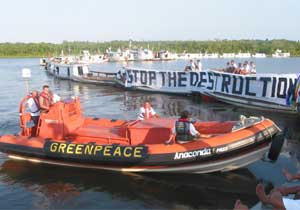
Two illegal logging barges carrying over two hundred logs have been impounded and the owner fined almost 200,000 Brazilian reals - nearly US$ 60,000, after a three-day river blockade mounted by Greenpeace activists and local community members in the Amazon to protest against forest destruction and demand the reation of an Extractive Reserve (1).
Over 40 small riverboats anchored across the 100-meter wide Jaraucu River - the main channel for the transport of illegal timber in the region during the protest. Over the weekend a metal barge carrying 113 illegally harvested logs was stopped. The skipper of the tugboat is the brother of the Mayor of Porto de Moz, André Campos. The barge tried to ram the blockade at high speed. A Greenpeace inflatable boat was able to deflect the barge into the riverbank, saving five small boats from destruction, and 86 local people, mostly children and elderly people, from serious injury or death. The barge crew reacted violently and three people were injured.
Protesters from Greenpeace and a journalist from the Brazilian TV network Record, also had to be rescued from the local airport at Porto de Moz by police after coming under threat from the logging community.
Ibama (the Brazilian Environmental Agency) agents seized the illegal logs on board the first barge and then later, together with Greenpeace and community members, impounded a second barge with 90 illegal logs onboard, also owned by a member of the Campos family.
"This is a no man's land. It's criminal that officials who are entrusted with public safety, like the Mayor of Porto de Moz, instead protect only their commercial interests, while the people of the region live in fear as their environment is destroyed" said Paulo Adario, Greenpeace Amazon Campaign Coordinator. "80 percent of the world's ancient forests are already destroyed, and the very people who could preserve the remainder are subjected to intimidation and violence."
The three-day protest was inspired by Chico Mendes, a world-renowned activist, who was murdered 14 years ago trying to protect the Amazon forest. His model of protest, known as empates or physical blockades of forest areas, was widely used in the 1980's. This is the first time a blockade of this type has been carried out since he died.
Notes
(1). Extractive Reserves are protected areas designated for the conservation and sustainable management of natural resources by the people who traditionally live in the area. This model was developed in the '80s by forest dwellers under the leadership of Chico Mendes and the National Council of Rubber Tappers (CNS) and adopted by the Brazilian Federal Government in 1990. These reserves guarantee local families the collective right to land and its natural resources, allowing them to keep on living from their traditional economic activities, while preserving the environment. In 1990, the Federal Government issued the Extractive Reserves General Decree establishing the legal basis for the creation of such unites.
(2) Porto de Moz is a small town at the mouth of the Xingu River, in the north of the Middle Land in Para State. It is home to approximately 125 communities with 15 thousand inhabitants living in rural and forest areas. The communities' goal is to create Verde Para Sempre (Forever Green), the largest extractive reserve in the world, which would help stop forest destruction and promote the sustainable use of natural resources. The proposed area is 1.3 million hectares, almost half the size of Belgium.

